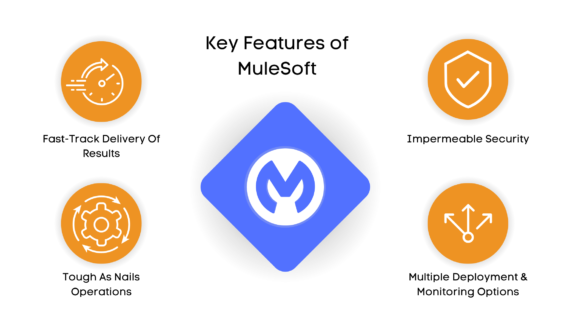Mule ESB, the runtime engine of Anypoint Platform, is a highly adaptable and lightweight Java-based enterprise service bus (ESB) and integration platform designed to facilitate seamless connectivity between diverse applications. With Mule ESB, developers can swiftly and effortlessly connect applications, enabling smooth data exchange between them. This platform excels at integrating existing systems, irrespective of the different technologies being utilized by the applications, encompassing JMS, Web Services, JDBC, HTTP, and more. Moreover, Mule ESB boasts universal connectivity and offers the flexibility of deployment anywhere, whether within your enterprise or across the Internet.
The fundamental advantage of an ESB like Mule is its ability to serve as a web interface for a transit system or application network that facilitates communication between different applications. Acting as a bridge or application network, it efficiently carries data between various applications, enhancing overall interoperability within the enterprise.
Key Features of MuleSoft
Unraveling the complexities of MuleSoft, we encounter four fundamental components that constitute the backbone of this integration platform. Understanding these elements is pivotal to fully leveraging MuleSoft’s capabilities to connect data, applications, and platform services, so let’s delve into each one:
Fast-Track Delivery Of Results
With an easy-to-implement framework, MuleSoft expedites the integration process. The platform has built-in assets and connectors, facilitating faster project integration. Furthermore, the reusable APIs, part of MuleSoft’s offering, not only speed up the current project timeline but also set a robust foundation for the efficient development and easy integration of future projects. Thus, MuleSoft ensures a streamlined delivery to deliver projects faster and results with increased productivity.
Tough As Nails Operations
MuleSoft is known for its resilience and reliability as a dependable platform for managing vast data. Its advanced technologies allow businesses to monitor runtime performances and topology graphs, providing actionable, real-time insights. With these insights, companies can make strategic decisions, eliminating guesswork and enabling a proactive approach to business operations.

Impermeable Security
Security is paramount in MuleSoft’s Anypoint platform. Adhering to the highest industry standards, anypoint platform MuleSoft ensures rigorous security and governance across all stages of an API’s lifecycle. It automatically applies the prescribed set of security measures and policies to all APIs, which safeguards data transmission across various applications, devices, platforms, and systems.
Multiple Deployment & Monitoring Options
MuleSoft offers flexibility in deployment options, catering to different business needs. These include Customer Hosted (On-Premises), CloudHub, Hybrid, and Kubernetes-based Runtime Fabric Manager. In addition, MuleSoft supports application deployment across 12 different AWS regions, maximizing reach and efficiency. To complement its deployment features, MuleSoft’s Anypoint platform provides real-time API monitoring, delivering key insights and metrics for comprehensive integration management.
How does Mulesoft work?
MuleSoft offers an extensive suite of pre-defined APIs for easy integration into various systems and applications. Integrating these APIs into your existing systems modernizes connectivity, even if the system functionality still needs to be fully understood. In cloud systems, a unique intermediary known as the System API plays a crucial role in interpreting modern system languages and facilitating data exchange. All APIs within MuleSoft interconnect, each fulfilling a distinct function.
Certain complex APIs handle the processing of extracted data. Interactive APIs manage data to be displayed on various multimedia platforms such as mobile devices, apps, desktops, and more, especially when implementing specific logic. This versatility extends to API development and execution within existing components of your system.
Adopting MuleSoft’s modern API-based approach for integration translates each integration into a reusable asset. This approach simplifies reusability, enabling businesses to rapidly adopt IT, enhance organizational agility, and drive innovative scalability. This isn’t just theoretical; impressive figures back it. Reports show MuleSoft customers achieved a staggering 445% return on investment over three years and saved 90% of development time by maintaining APIs and integrations.
Components of MuleSoft Anypoint Platform
To help you better understand this topic and the architecture of MuleSoft, we encounter several vital components that orchestrate this powerful integration platform.
- Anypoint Studio: Serving as the Integrated Development Environment (IDE) of MuleSoft, Anypoint Studio provides a graphical environment for designing, building, and testing application integrations. This visual interface simplifies complex integration processes, making it more accessible to users of varying technical proficiency.
- Mule Runtime: At the heart of MuleSoft is the Mule Runtime, a lightweight yet potent engine responsible for executing integrations. Known for its scalability and high performance, it ensures efficient and effective data exchange within the organization or with external entities.
- CloudHub: As MuleSoft’s integration platform as a service (iPaaS), CloudHub facilitates the deployment and management of integrations in the cloud. This cloud-native capability allows for flexible and scalable integration solutions that can quickly adapt to changing business needs.
- Connectors: MuleSoft provides an array of pre-built connectors that streamline the integration with a wide range of systems, applications, and services. Working as plug-and-play components, these connectors significantly reduce the time and effort required for custom integration.
- Anypoint Exchange: This is MuleSoft’s repository for discovering, sharing, and reusing APIs, connectors, and templates. By facilitating the reuse of assets, Anypoint Exchange enhances efficiency and promotes a culture of collaboration among developers.
- Anypoint Monitoring: Equipped with robust monitoring and analytics capabilities, Anypoint Monitoring offers insightful visibility into the performance of your integrations. These insights enable proactive issue identification and resolution, minimizing downtime and maintaining seamless data flow.
- Anypoint Security: MuleSoft strongly emphasizes data protection and compliance with its Anypoint Security. Offering an array of security features and policies, it ensures the safe transit of data across all integrations, safeguarding your organization’s valuable information assets.
The Benefits of Using MuleSoft
Harnessing the power of MuleSoft equips organizations with numerous advantages that translate to strategic and operational benefits.
- Efficiency and Productivity Gains: One of the most compelling reasons to use MuleSoft is the drastic efficiency improvement it brings to application and data integration. By streamlining complex integrations, MuleSoft significantly reduces the time and effort required, leading to heightened productivity. Reusable APIs and pre-built connectors eliminate the need for redundant work, allowing teams to focus on core business activities.
- Enhanced Collaboration: MuleSoft fosters a collaborative environment among teams and departments. The platform’s shared repository, Anypoint Exchange, encourages the discovery, sharing, and reuse of APIs, connectors, and templates. This cross-departmental collaboration helps break down silos and aligns different teams toward a common organizational goal.
- Cost-Savings: MuleSoft is a cost-effective solution that brings substantial savings to organizations. The need for extensive custom coding is significantly reduced, saving financial resources and valuable time. The quick implementation times, coupled with the reduction in maintenance costs due to reusable components, translate to a lower total cost of ownership.
- Innovation and Agility: MuleSoft’s platform empowers businesses to respond rapidly to changing market dynamics. The agility derived from MuleSoft’s efficient integration process and its robust, scalable architecture enables organizations to innovate at a faster pace, stay competitive and meet evolving business demands.
Leveraging MuleSoft service cloud-first, organizations can capitalize on their data and applications, bringing their operations, sales and service cloud to new heights of efficiency and effectiveness.
MuleSoft in Action: What Is MuleSoft Used For?
In the bustling landscape of business innovation, MuleSoft has emerged as a game-changing catalyst for organizations across various sectors. By seamlessly connecting disparate systems and enabling fluid data exchange, MuleSoft has revolutionized how businesses operate and deliver value. From healthcare to retail, finance, and education, organizations are leveraging MuleSoft’s integration capabilities to overcome challenges and accelerate growth. Let’s delve into the transformation MuleSoft has instigated across these sectors, followed by real-world examples that testify to its power:

Mulesoft IIndustries
MuleSoft Integration Solutions for Healthcare Industry
In a sector where instant access to accurate data can mean the difference between life and death, MuleSoft brings disparate systems, such as Electronic Health Records (EHR), billing systems, and other critical applications, onto one integrated platform. This seamless connectivity ensures real-time data access, improving patient care and operational efficiency.
For instance, UCSF Health, a leading healthcare provider, leveraged MuleSoft to unify patient data from multiple sources, leading to enhanced healthcare delivery and higher patient satisfaction.
MuleSoft Integration Solutions for Retail
Retailers today face the daunting task of delivering a seamless omnichannel experience to customers. MuleSoft helps integrate online and in-store data, inventory systems, and customer databases, thus enabling a consistent and personalized customer experience.
Take the example of ASICS, a global sports retailer that used MuleSoft to integrate e-commerce systems and CRM data across regions. This helped ASICS deliver personalized online experiences and improve global e-commerce sales.
MuleSoft Integration Solutions for Fintech
MuleSoft has helped financial institutions integrate their legacy systems with modern fintech applications for streamlined operations and improved customer service in an era of rapid evolution.
HSBC, a multinational bank, harnessed the power of MuleSoft to develop a global, API-led strategy that streamlined processes and enabled faster innovation, leading to an enhanced banking experience for their customers.
MuleSoft Integration Solutions for Education Industry
MuleSoft has played a significant role in modernizing educational institutions by integrating student information systems, learning management systems, and administrative software into a unified platform. This has enhanced communication, facilitated efficient data management, and enriched the learning experience.
For instance, Deakin University used MuleSoft to create a seamless digital campus experience, integrating numerous systems and providing students with personalized, real-time information.
In each of these scenarios, MuleSoft has proven to be more than just an integration platform; it has acted as a catalyst for operational excellence and innovative growth, underscoring its significance in today’s digital transformation landscape.
Getting Started with MuleSoft
In the journey to unlock the full potential of MuleSoft, proactive self-learning is undoubtedly an advantageous approach. Numerous resources are available for those ambitious enough to explore this integration platform’s vast possibilities. From comprehensive guides to hands-on tutorials, MuleSoft provides a plethora of opportunities for individual education.
Yet, the mastery of this extensive platform doesn’t happen in isolation. It can be significantly expedited through the guidance of seasoned experts. These professionals, with their years of experience and impressive portfolio of successfully executed projects, bring a wealth of practical knowledge that can navigate through the intricacies of MuleSoft. Such an interaction offers a superior, more in-depth understanding that surpasses the limitations of independent learning. The value they provide is substantial, investing in their expertise not just a purchase but a strategic move towards optimized integration, ensuring one can extract maximum value from the MuleSoft platform.
Choosing the Right Partner for MuleSoft Integration
Navigating the increasingly interconnected digital landscape can be challenging, but with the right tools and partners, it becomes a journey of innovation, data transformation and growth. Throughout this article, we have explored MuleSoft’s powerful capabilities, showcasing its comprehensive approach to integration and highlighting how it efficiently addresses the modern challenges businesses face.
As we’ve discussed, MuleSoft is more than just a platform – it is a transformative tool for organizations to streamline their business processes together, foster collaboration, and drive innovation. As you explore your organization’s integration needs, consider the potential impact of MuleSoft.
This journey, however, does not have to be taken alone. Identifying the right partner to guide your MuleSoft integration can make all the difference. So, explore your options, ask the right questions, and take the leap toward a more integrated and efficient future with MuleSoft.


